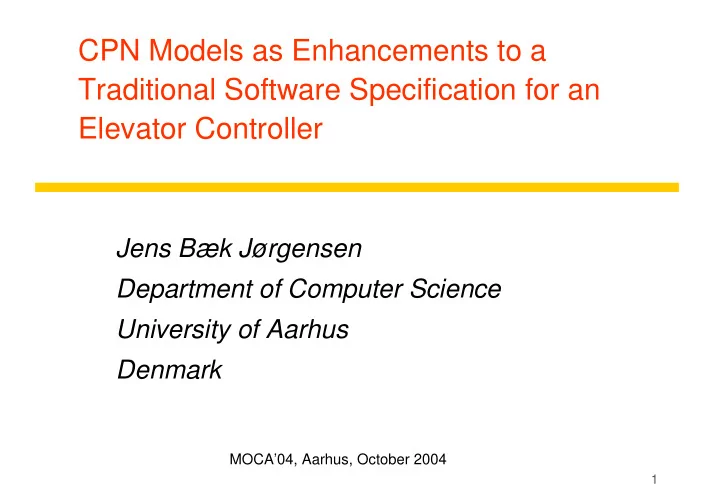

CPN Models as Enhancements to a Traditional Software Specification for an Elevator Controller Jens Bæk Jørgensen Department of Computer Science University of Aarhus Denmark MOCA’04, Aarhus, October 2004 1
Problem: design of an elevator controller � Subject domain � Ten floors � Two cages � Buttons, doors, sensors, … � Controller responsibilities � Control movement of cages � Display information 2
Wieringa’s specification: desired functionality � Mission statement, function refinement tree, service descriptions � Partial context diagram � Also dictionary and descriptions of entities in subject domain 3
Wieringa’s specification: desired behaviour of cage movement Also descriptions of desired behaviour of allocation of request to cages, location indication, etc. 4
CPN model: representation of controller specification � Set of Standard ML functions � setdirection � stophere � turnidle � servenow � resetdirection � addrequest � removerequest � updatelocationindicators 5
CPN model: desired behaviour of subject domain Entities in subject domain represented as tokens – cages as (cageid,floor,requestlist, direction) Three net modules: - Basic Cage Movement - Requests and Allocations - UpDown and Indicators 6
CPN model: requirements-level architecture � Representation of controller � Processes ~ Standard ML functions � Data stores ~ tokens � Representation of subject domain � Entities ~ tokens � Communications � Possible internal communications in system ~ transitions � Possible communications between controller and entities in environment ~ transitions 7
CPN model: basis for system engineering argument � Argue that specification and domain properties together entail requirements � Prerequisites for argument � CPN model executable � CPN model coherent � Example requirement: Collect passengers � Trigger: Passenger pushes floor button F � Delivered service: Controller ensures that cage stops at floor F and allows passengers to enter 8
Some perspectives on CPN in software engineering � Compliance with Jackson’s basic tenets � Distinguish the machine from the problem domain � Don’t restrict description to the machine � State explicitly what is described � Advantages compared with statecharts � CPN adequate to address scheduling � CPN conveniently describe two cages together � CPN facilitate prototyping and experiments 9
Conclusions and discussion � Advantages of adding CPN model � Can be used as requirements-level architecture � Facilitates system engineering argument � Cost-benefit issues of adding CPN model � Gap between model and implementation � Can existing specification be improved with simpler means? � Formal verification viable? � Improve quality of system engineering argument � Argue about more advanced behavioural properties � Scalability problems 10
Recommend
More recommend